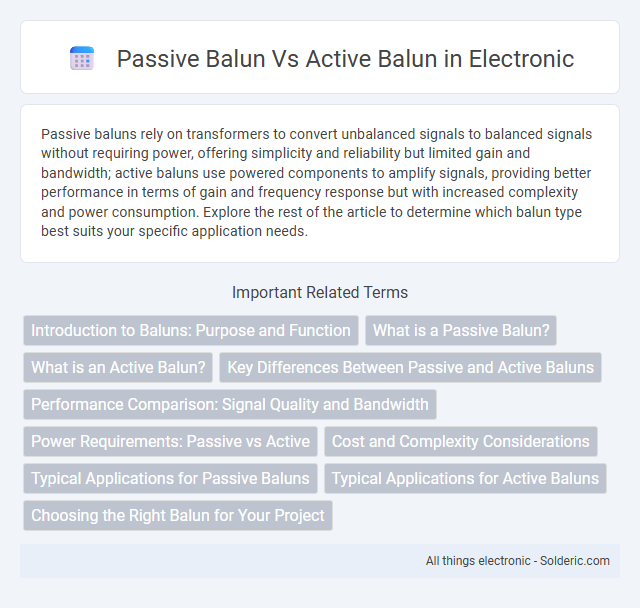Passive baluns rely on transformers to convert unbalanced signals to balanced signals without requiring power, offering simplicity and reliability but limited gain and bandwidth; active baluns use powered components to amplify signals, providing better performance in terms of gain and frequency response but with increased complexity and power consumption. Explore the rest of the article to determine which balun type best suits your specific application needs.
Comparison Table
| Feature | Passive Balun | Active Balun |
|---|---|---|
| Signal Amplification | No amplification; only impedance matching and signal conversion | Includes amplification for signal boosting |
| Power Requirement | No external power needed | Requires external power or battery |
| Noise Level | Low noise, purely passive device | Potentially higher noise due to active components |
| Frequency Range | Typically broad frequency range | Frequency range may be limited by active components |
| Complexity & Cost | Simple design, low cost | More complex, higher cost |
| Applications | Ideal for impedance matching and signal balancing without gain | Used when signal amplification is necessary along with conversion |
Introduction to Baluns: Purpose and Function
Baluns serve as essential devices that convert between balanced and unbalanced signals, enabling efficient signal transmission in various RF and audio applications. Passive baluns rely on transformers or transmission line structures without external power, offering simplicity and low distortion but limited frequency range and gain. Active baluns incorporate amplification circuits powered by an external source, providing enhanced bandwidth, gain, and impedance matching for your demanding communication systems.
What is a Passive Balun?
A passive balun is a transformer-based device that converts between balanced and unbalanced signals without requiring an external power source. It relies on magnetic coupling and impedance matching to maintain signal integrity while minimizing distortion and noise. Passive baluns are commonly used in radio frequency (RF) applications, antenna systems, and audio interfaces where simplicity and reliability are essential.
What is an Active Balun?
An active balun is an electronic device that converts unbalanced signals to balanced signals using powered components like transistors or integrated circuits, providing signal amplification and improved noise performance. Unlike passive baluns, which rely solely on transformers or passive components and do not boost signal strength, active baluns require an external power source to function. Your choice between active and passive baluns depends on the need for signal gain, noise reduction, and overall system performance.
Key Differences Between Passive and Active Baluns
Passive baluns operate without external power and rely on transformers or transmission lines to convert signals, making them simple, reliable, and cost-effective for basic applications. Active baluns use powered electronic components to provide signal amplification and better noise performance, enhancing signal strength and extending transmission distance. Your choice depends on whether you need improved signal quality and range (active) or a straightforward, low-maintenance solution (passive).
Performance Comparison: Signal Quality and Bandwidth
Passive baluns offer lower signal distortion and inherently wide bandwidth without requiring external power, making them suitable for balanced-to-unbalanced signal conversion in RF applications where simplicity and reliability are critical. Active baluns, incorporating amplification, provide improved signal gain and better noise performance, enhancing signal quality especially in low-level or weak signal environments, but their bandwidth may be narrower due to internal circuitry limitations. Selection between passive and active baluns depends on required signal integrity, bandwidth demands, and system power availability within specific communication and audio frequency systems.
Power Requirements: Passive vs Active
Passive baluns require no external power source as they rely solely on transformer action or transmission line principles to convert signals, making them energy-efficient for applications where power availability is limited. Active baluns incorporate powered electronic components such as amplifiers or active circuits, necessitating an external power supply to function, which increases power consumption but enhances signal strength and performance in low-signal conditions. The choice between passive and active baluns depends on balancing power availability against signal amplification needs in specific RF or networking setups.
Cost and Complexity Considerations
Passive baluns offer lower cost and simpler design by using only passive components such as transformers or inductors, making them ideal for budget-conscious and straightforward applications. Active baluns incorporate amplifiers and require power, increasing both complexity and cost due to additional circuitry and power management. Your choice depends on whether you prioritize minimal expense and ease of use or enhanced performance with higher investment.
Typical Applications for Passive Baluns
Passive baluns are commonly used in applications such as FM radio antennas, CCTV systems, and amateur radio setups because they do not require an external power source and offer low noise performance. These devices efficiently convert balanced signals to unbalanced signals for systems where signal amplification is unnecessary or minimal. Your choice of a passive balun is ideal for environments prioritizing simplicity, durability, and minimal maintenance.
Typical Applications for Active Baluns
Active baluns are commonly utilized in applications requiring signal amplification and impedance matching, such as HDTV antennas, cable television systems, and wireless communications. These devices enable improved signal quality and longer transmission distances compared to passive baluns, making them ideal for indoor antennas and environments with weak signals. Your choice of an active balun can significantly enhance reception performance in setups demanding low noise amplification and consistent signal strength.
Choosing the Right Balun for Your Project
Passive baluns operate without external power, providing reliable signal transformation through transformers and are ideal for simple, low-noise applications like FM antennas. Active baluns incorporate amplification circuits powered by electricity, enhancing weak signals and improving performance in long cable runs or indoor antenna setups. Selecting the right balun depends on factors such as signal strength, noise levels, power availability, and project environment to ensure optimal signal quality and system efficiency.
passive balun vs active balun Infographic

 solderic.com
solderic.com